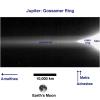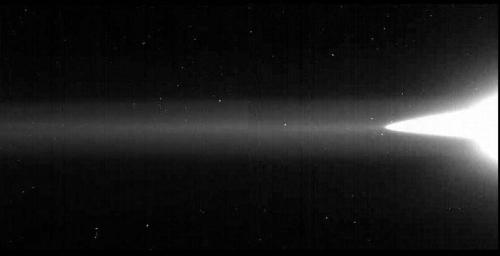Jupiter's ring system is composed of three parts: a flat main ring, a toroidal halo interior to the main ring, and the gossamer ring, which lies exterior to the main ring. The gossamer ring is the extremely diffuse and uniform band that stretches across the center of this mosaic, starting from the main ring and halo on the right-hand side. The gossamer ring had been seen previously only in the single Voyager image in which it was discovered at a very low brightness level; there its brightness appeared to drop from about one-tenth the main ring's value until the ring totally vanished at a distance of about three Jovian radii. The gossamer ring is clearly visible in this Galileo view; the left side of the image corresponds to a radial distance of about 2.2 Jovian radii. The outer edge of the gossamer ring is beyond the edge of this mosaic.

Jupiter's gossamer ring
To accentuate the very faint, gossamer ring, the images were overexposed with respect to the main ring and the halo (both seen on the far right of the mosaic). In these long exposures, some stars are visible; other specks in the mosaic were caused by cosmic ray hits to the CCD. All parts of the Jovian rings scatter sunlight very efficiently in the forward direction, indicating that the particles are micrometers or less in diameter, small than the thickness of tissue paper. Such small particles are believed to have human-scale lifetimes, i.e., very brief compared to the solar system's age.
These images were taken through the clear filter (610 nanometers) of the solid state imaging (CCD) system aboard NASA's Galileo spacecraft on November 9, 1996. The resolution is approximately 46 kilometers per picture element from right to left; however, because the spacecraft was only about 0.5 degrees above the ring plane, the image is highly foreshortened in the vertical direction. The images were obtained when Galileo was in Jupiter's shadow, peering back toward the Sun; the ring was approximately 2.3 million kilometers (1.4 million miles) away. Jupiter lies about a full frame off the right edge.
The view of Earth's moon included in the explanatory graphics was created from imagery returned by the BMDO/NASA Clementine lunar orbiter which was launched in early 1994. (BMDO is Ballistic Missile Defense Organization.)
The Jet Propulsion Laboratory, Pasadena, CA manages the Galileo mission for NASA's Office of Space Science, Washington, DC.
This image and other images and data received from Galileo are posted on the World Wide Web, on the Galileo mission home page at URL http://galileo.jpl.nasa.gov. Background information and educational context for the images can be found at http://www.jpl.nasa.gov/galileo/sepo.

 Planetary Data System
Planetary Data System













